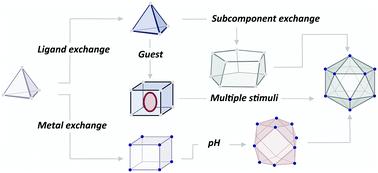当前位置:
X-MOL 学术
›
Chem. Soc. Rev.
›
论文详情
Our official English website, www.x-mol.net, welcomes your feedback! (Note: you will need to create a separate account there.)
Transformation networks of metal–organic cages controlled by chemical stimuli
Chemical Society Reviews ( IF 46.2 ) Pub Date : 2022-06-06 , DOI: 10.1039/d0cs00801j Elie Benchimol 1 , Bao-Nguyen T Nguyen 1 , Tanya K Ronson 1 , Jonathan R Nitschke 1
Chemical Society Reviews ( IF 46.2 ) Pub Date : 2022-06-06 , DOI: 10.1039/d0cs00801j Elie Benchimol 1 , Bao-Nguyen T Nguyen 1 , Tanya K Ronson 1 , Jonathan R Nitschke 1
Affiliation

|
The flexibility of biomolecules enables them to adapt and transform as a result of signals received from the external environment, expressing different functions in different contexts. In similar fashion, coordination cages can undergo stimuli-triggered transformations owing to the dynamic nature of the metal–ligand bonds that hold them together. Different types of stimuli can trigger dynamic reconfiguration of these metal–organic assemblies, to switch on or off desired functionalities. Such adaptable systems are of interest for applications in switchable catalysis, selective molecular recognition or as transformable materials. This review highlights recent advances in the transformation of cages using chemical stimuli, providing a catalogue of reported strategies to transform cages and thus allow the creation of new architectures. Firstly we focus on strategies for transformation through the introduction of new cage components, which trigger reconstitution of the initial set of components. Secondly we summarize conversions triggered by external stimuli such as guests, concentration, solvent or pH, highlighting the adaptation processes that coordination cages can undergo. Finally, systems capable of responding to multiple stimuli are described. Such systems constitute composite chemical networks with the potential for more complex behaviour. We aim to offer new perspectives on how to design transformation networks, in order to shed light on signal-driven transformation processes that lead to the preparation of new functional metal–organic architectures.
中文翻译:

受化学刺激控制的金属-有机笼的转换网络
生物分子的灵活性使它们能够根据从外部环境接收到的信号进行适应和转换,在不同的环境中表达不同的功能。以类似的方式,由于将它们结合在一起的金属-配体键的动态特性,配位笼可以经历刺激触发的转变。不同类型的刺激可以触发这些金属有机组件的动态重新配置,以打开或关闭所需的功能。这种适应性强的系统对于在可转换催化、选择性分子识别或可转化材料中的应用具有重要意义。这篇综述重点介绍了使用化学刺激改造笼子的最新进展,提供了一份报告的改造笼子的策略目录,从而允许创建新的架构。首先,我们通过引入新的笼子组件来关注转型策略,这会触发初始组件集的重组。其次,我们总结了由外部刺激(如客人、浓度、溶剂或 pH 值)触发的转换,强调了协调笼可以经历的适应过程。最后,描述了能够响应多种刺激的系统。这样的系统构成了具有更复杂行为潜力的复合化学网络。我们的目标是为如何设计转换网络提供新的视角,以阐明信号驱动的转换过程,从而制备新的功能性金属-有机架构。这触发了初始组件集的重组。其次,我们总结了由外部刺激(如客人、浓度、溶剂或 pH 值)触发的转换,强调了协调笼可以经历的适应过程。最后,描述了能够响应多种刺激的系统。这样的系统构成了具有更复杂行为潜力的复合化学网络。我们的目标是为如何设计转换网络提供新的视角,以阐明信号驱动的转换过程,从而制备新的功能性金属-有机架构。这触发了初始组件集的重组。其次,我们总结了由外部刺激(如客人、浓度、溶剂或 pH 值)触发的转换,强调了协调笼可以经历的适应过程。最后,描述了能够响应多种刺激的系统。这样的系统构成了具有更复杂行为潜力的复合化学网络。我们的目标是为如何设计转换网络提供新的视角,以阐明信号驱动的转换过程,从而制备新的功能性金属-有机架构。描述了能够响应多种刺激的系统。这样的系统构成了具有更复杂行为潜力的复合化学网络。我们的目标是为如何设计转换网络提供新的视角,以阐明信号驱动的转换过程,从而制备新的功能性金属-有机架构。描述了能够响应多种刺激的系统。这样的系统构成了具有更复杂行为潜力的复合化学网络。我们的目标是为如何设计转换网络提供新的视角,以阐明信号驱动的转换过程,从而制备新的功能性金属-有机架构。
更新日期:2022-06-06
中文翻译:

受化学刺激控制的金属-有机笼的转换网络
生物分子的灵活性使它们能够根据从外部环境接收到的信号进行适应和转换,在不同的环境中表达不同的功能。以类似的方式,由于将它们结合在一起的金属-配体键的动态特性,配位笼可以经历刺激触发的转变。不同类型的刺激可以触发这些金属有机组件的动态重新配置,以打开或关闭所需的功能。这种适应性强的系统对于在可转换催化、选择性分子识别或可转化材料中的应用具有重要意义。这篇综述重点介绍了使用化学刺激改造笼子的最新进展,提供了一份报告的改造笼子的策略目录,从而允许创建新的架构。首先,我们通过引入新的笼子组件来关注转型策略,这会触发初始组件集的重组。其次,我们总结了由外部刺激(如客人、浓度、溶剂或 pH 值)触发的转换,强调了协调笼可以经历的适应过程。最后,描述了能够响应多种刺激的系统。这样的系统构成了具有更复杂行为潜力的复合化学网络。我们的目标是为如何设计转换网络提供新的视角,以阐明信号驱动的转换过程,从而制备新的功能性金属-有机架构。这触发了初始组件集的重组。其次,我们总结了由外部刺激(如客人、浓度、溶剂或 pH 值)触发的转换,强调了协调笼可以经历的适应过程。最后,描述了能够响应多种刺激的系统。这样的系统构成了具有更复杂行为潜力的复合化学网络。我们的目标是为如何设计转换网络提供新的视角,以阐明信号驱动的转换过程,从而制备新的功能性金属-有机架构。这触发了初始组件集的重组。其次,我们总结了由外部刺激(如客人、浓度、溶剂或 pH 值)触发的转换,强调了协调笼可以经历的适应过程。最后,描述了能够响应多种刺激的系统。这样的系统构成了具有更复杂行为潜力的复合化学网络。我们的目标是为如何设计转换网络提供新的视角,以阐明信号驱动的转换过程,从而制备新的功能性金属-有机架构。描述了能够响应多种刺激的系统。这样的系统构成了具有更复杂行为潜力的复合化学网络。我们的目标是为如何设计转换网络提供新的视角,以阐明信号驱动的转换过程,从而制备新的功能性金属-有机架构。描述了能够响应多种刺激的系统。这样的系统构成了具有更复杂行为潜力的复合化学网络。我们的目标是为如何设计转换网络提供新的视角,以阐明信号驱动的转换过程,从而制备新的功能性金属-有机架构。

























 京公网安备 11010802027423号
京公网安备 11010802027423号